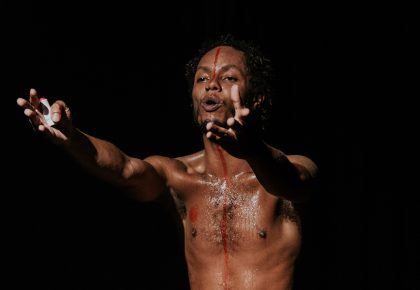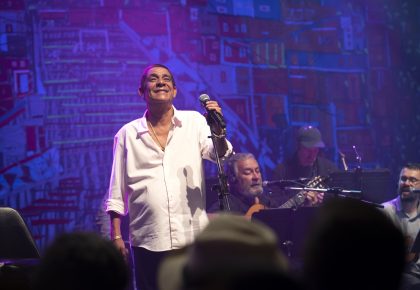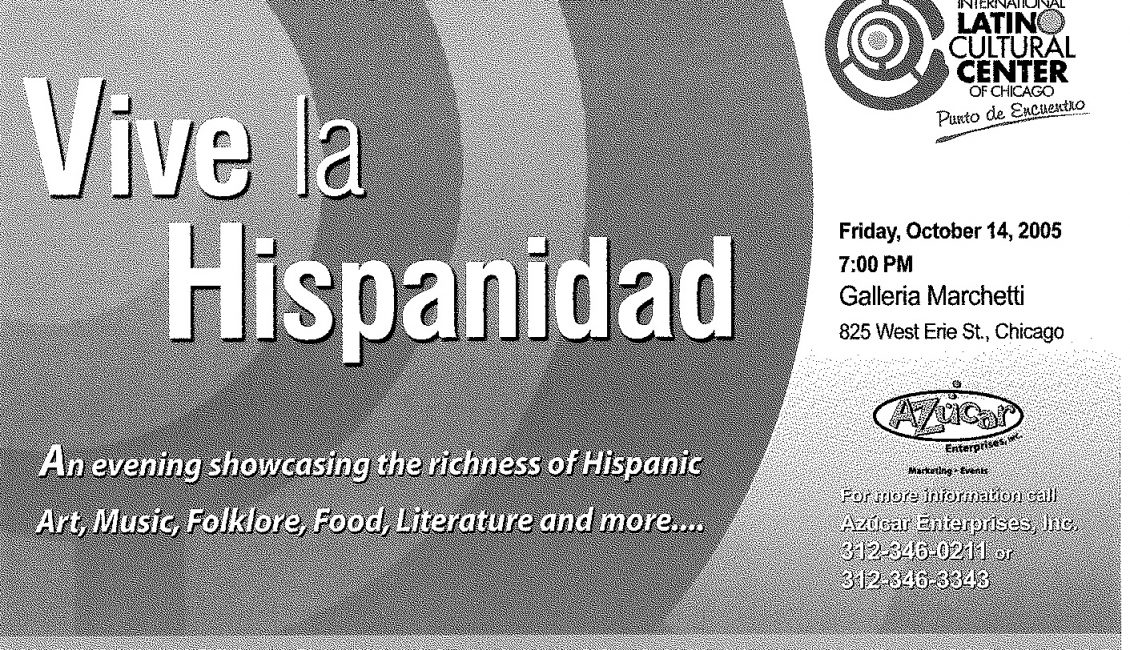
This is the fifth in a series of columns celebrating the 25th anniversary of the International Latino Cultural Center of Chicago and its many accomplishments. The ILCC is currently engaged in a fundraising campaign to raise the funds necessary to help the organization increase its free citywide programming as well as create new multi-disciplinary programming and fund the infrastructure that will make these programs possible.
Although film, music and theater remain the International Latino Cultural Center’s three strongest programming pillars, the lack of a permanent home for the ILCC has made it impossible for the organization to consistently program, for example, art exhibitions, culinary events, and even literary presentations (we could not find in our archives any evidence of any literary event such as poetry readings and conferences that the ILCC might have presented or co-presented since its name change). The ILCC did solidify its dance programming through the annual Chicago Latino Dance Festival, a three to four day showcase of over 20 local Latino and Spanish dance companies held weekly throughout the city in the fall.
What follows is a quick overview of the many other events presented and co-presented by the ILCC these past 25 years:
VISUAL ARTS
Founded in in 1993 Chicago’s River North neighborhood, a gallery hot spot at the time, by Nicaraguan artist, dealer and curator Aldo Castillo, the Aldo Castillo Gallery quickly established a high benchmark in the curation and exhibition of Latin American and Iberian art in Chicago, so it made perfect sense that the International Latino Cultural Center of Chicago would join forces with the gallery.
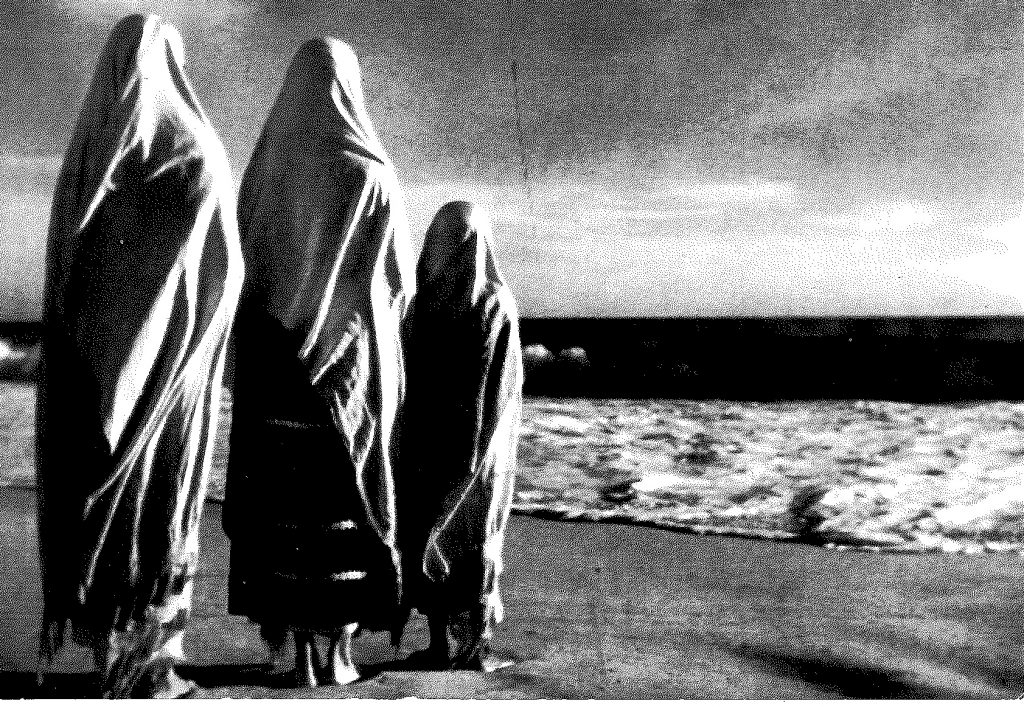
The first collaboration we have a record of took place in 2000 when the Aldo Castillo Gallery and the 16th annual Chicago Latino Film Festival presented The Mexican Golden Age of Cinematography: Photographs by Gabriel Figueroa, a selection of mostly black and white stills from the films shot by the Golden Globe-winning legendary cinematographer. The exhibit was held from March 29-April 22, 2000.
Two years later, both organizations presented an exhibit of Alejandro Quijano’s recent bronze sculptures with the title: Alejandro Quijano Without Masks from May 8-June 14. The exhibit was part of the International Guest Artists Program, a joint project of the ILCC and the Aldo Castillo Gallery which provided funding to emerging and established artists from selected Latin American countries and Spain to be able to show and promote their works in Chicago, to personally experience the cultural contributions of the city, and for all people to experience a one of a kind exposure to the universality of the arts.
The following month, the ILCC and Aldo Castillo Gallery brought together four members of the Uruguayan Foundation for the Arts for the exhibit Uruguayan Art Today (July 12-27, 2002): figurative painter Elisa Armendariz; painter Ana Méndez (whose work is inspired by the work of Jorge Luis Borges); the daydream like mixed media work of Martín Mendizábal; and Juan Pedro Paz.
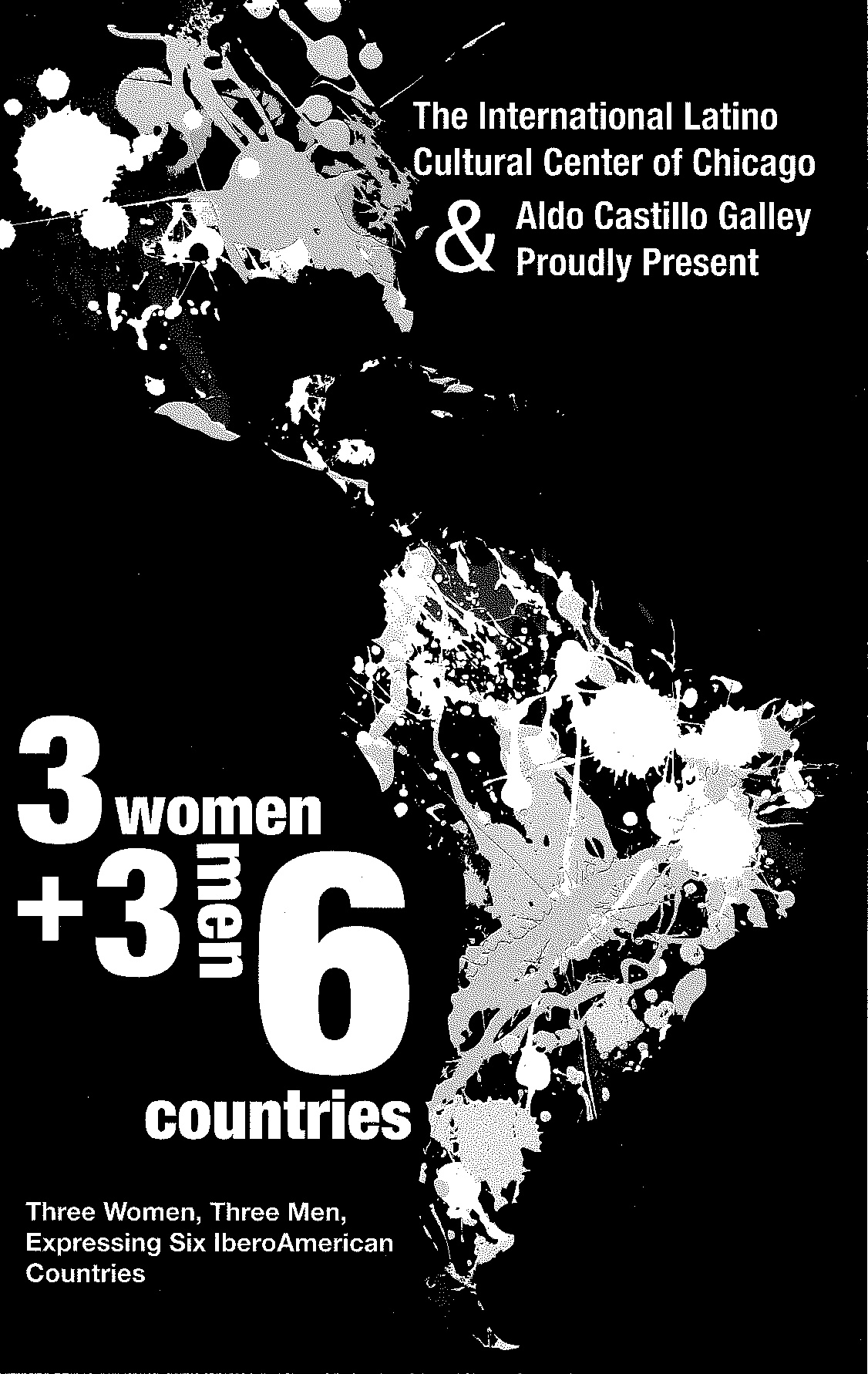
In 2005 and every two years after that (until 2009), the ILCC and Aldo Castillo presented 3+3=6: Three Men, Three Women, Six Countries, a showcase dedicated to the most influential Latin American and Spanish artists. The four exhibits (August 5-31, 2005; July 18-August 30, 2007; August 10-September 1, 2007; and July 31-August 28, 2009) we have record of featured such renowned artists and diverse styles and approaches as Maria Bonomi’s (Brazil) monumental engravings, Haydee Victoria Suescum’s (Panamá) spin on the many hand-painted signs encountered in the Spanish-speaking areas of the United States; Haitian Fritz Millevoix’s’ naive or primitive style paintings featuring mountain village scenes, underwater mermaid villages, and Caribbean beach scenes; theatre and film set designer Gunther Gerzso (Mexico); and Miguel Gómez, whose paintings pay homage to the color, the dance and the carnival culture of his native Dominican Republic.
After accepting the role of assistant art director for the Miami International Art Fair in 2010, Aldo Castillo closed the doors of his River North gallery and relocated to Naples, where he opened a brand new gallery and continued his mission of positioning the work of contemporary Latin American and Spanish artists in the international arts market.
We found one more photo exhibit presented by the ILCC outside of its collaborations with the Aldo Castillo Gallery. Held between April 3-14, 2000 at the atrium of what was then the James R. Thompson Center and is today the future downtown Chicago headquarters of Google, the Solmares Photography Exhibition showcased a number of photos of the Mexican Revolution by photographer Agustín Víctor Casasola, featuring images of Francisco I. Madero’s presidential campaign and the signing of the 1917 Mexican Constitution.
NUESTRO FOLKLORE
What would a culture be, or even mean, without its traditions?
They provide stability, meaning, identity and community to a whole village, town, or even country. Those traditions may evolve, may even be re-invented but no matter how much you recombine its DNA, the essence still remains.
Tradition has never been far behind in the ILCC’s programming, even as it partnered with galleries or organized classical music events and festivals. So whenever the opportunity was there to feature one of our many traditional dances and dance ensembles or storytellers and even musicians, the ILCC did not think twice about it.
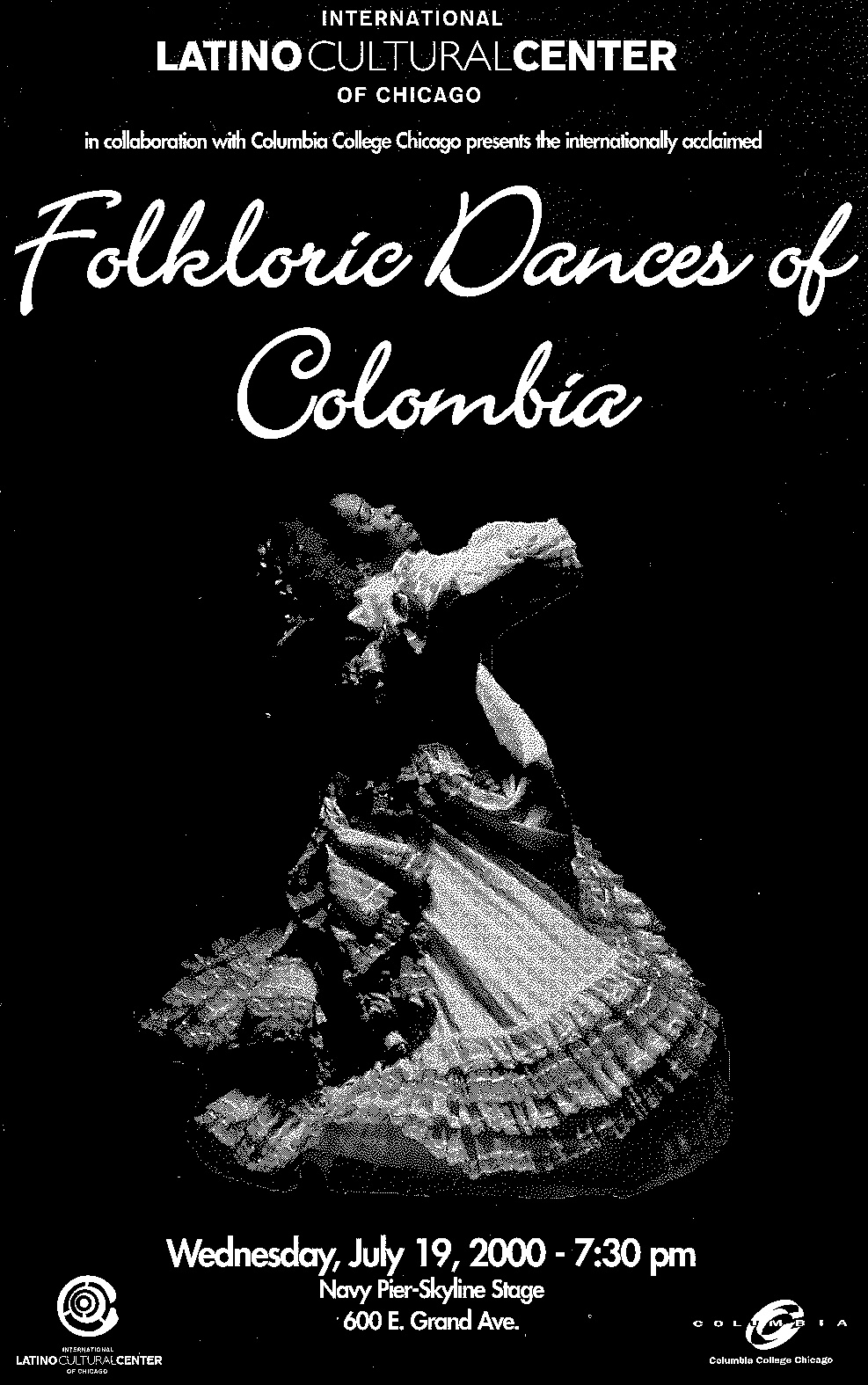
On July 19, 2000, the ILCC, with Lake Michigan as a spectacular backdrop, proudly presented Folkloric Dances of Colombia at Navy Pier’s Skyline Stage. Formed in 1954 by Delia Zapata Olivella to preserve the customs and traditions of Colombia, the company’s program showcased the diversity of the country’s musical and dance expressions: from the waltz-like el pasillo to el joropo and the ritualistic dances of mapalé. Alas, this would be one of the company’s final performances under Zapata Olivella’s direction; she passed away the following year.
Other folk-related events produced by the ILCC that they have records for on their archives:
Aztec Stories (October 12, 2002): Held at West Side Technical Institute (now the Arturo Velázquez Institute), 2800 S. Western Ave., the all-family cultural, educational, musically interactive presentation featured storyteller, musician and poet Michael Heralda who told stories about the legacy of the tortilla and the meanings of Xochitl and Kuikatl, among others.
Carnaval Ponceño (July 26, 2003): Held at Roberto Clemente High School, 1147 N. Western Ave., in the mostly Puerto Rican neighborhood of Humboldt Park, the event featured a performance of traditional dances and marches accompanied by bomba and plena rhythms provided by Africaribe.
Niños del Vallenato (July 20, 2005): An extraordinary troupe of children from Valledupar, Colombia, whose ages range from 6 to 18 years and who play the accordions, sing and dance, performed at the Merle Reskin Theatre.
FUNDRAISERS
The 25th anniversary dinner celebration of the ILCC at CineCity Studios, 2429 West 14th St. on Friday, November 14 is the first true fundraiser the organization has held in more than a decade. But 20 years ago and for seven consecutive years, the International Latino Cultural Center of Chicago in association with the marketing and events agency Azúcar Enterprises celebrated Hispanic Heritage Month with a series of annual fundraisers titled Vive la Hispanidad.
Held first at Galleria Marchetti, 825 West Erie St., in the River North neighborhood, for several years before moving to the now shuttered Germania Place in the Old Town neighborhood, the multidisciplinary fundraising event featured a catered selection of traditional dishes from the city’s top Latin American restaurants; wines from Chile and Argentina; an art exhibit from Chicago’s top Latino artists; and music from local Latino groups including Mariachi Perla de México, Africaribe, Tierra Colombiana Folkloric Dance Company, Chicago Samba, and Cerqua Rivera Dance Company
FILM OUTSIDE THE FESTIVAL
We end right where we started…at the movies.
The Chicago Latino Film Festival may be the ILCC’s crown jewel but that didn’t stop the organization from screening films from the Pan-Latino diaspora when there was an opportunity to do so outside of the Festival, especially when, outside of the streaming services, the theatrical presentation of such films in this country is still minimal.
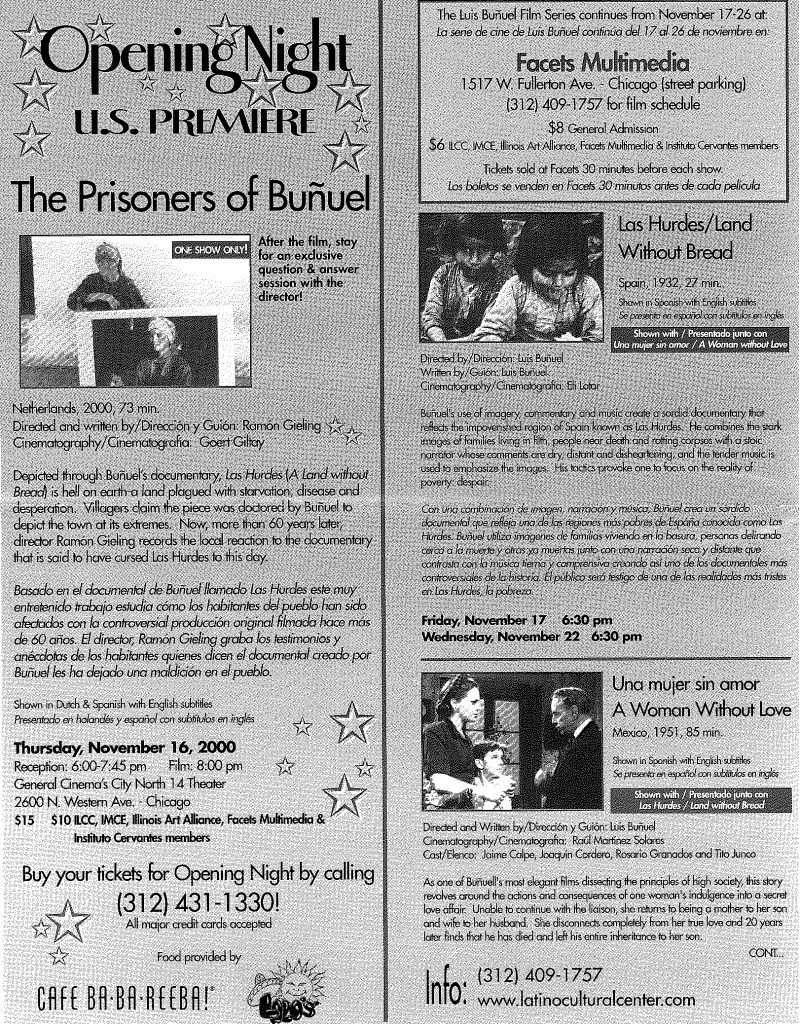
On November 16, 2000, the ILCC kicked off a ten day retrospective of the films of Luis Buñuel in celebration of his birth’s centennial. The retrospective opened at the City North 14 Multiplex in Logan Square with the U.S. Premiere of The Prisoners of Buñuel by director Ramón Gieling, a documentary about how the residents of Las Hurdes feel about Buñuel’s controversial 1933 documentary Las Hurdes/Land Without Bread, more than 60 years after its making. The thirteen-film series then moved to Facets Film Forum and included such key titles as Los olvidados (1950), Nazarín (1958) The Exterminating Angel (1962), and The Discreet Charm of the Bourgeoisie (1972).
The ILCC celebrated another centennial four years later with another retrospective: Pablo Neruda’s. Titled Cien Años de Neruda: A Film Series and presented again at Facets from November 19-21, 2004 in cooperation with Columbia College Chicago, the UIC Rafael Contrón-Ortiz Latino Cultural Center and the Consulate General of Chile, the series included two documentaries by Luis R. Vera: Neruda, the Man and His Work (2004) and Viola Chilensis (2003), the most comprehensive documentary at the time on the life and work of another Chilean icon, singer-songwriter Violeta Parra. The series also included a special screening of Micharl Radford’s critically acclaimed Il Postino, about the friendship between Neruda and a local fisherman during the poet’s exile in Italy.
For the past 17 years, the ILCC’s monthly Reel Film Club series has featured, on the last Tuesday of the month from January to February and from May through November, selections from past festivals preceded by a networking reception featuring appetizers from the selected film’s country of origin and concluding with a post-screening discussion. The series has moved from venue to venue: from Facets to St. Augustine College to Instituto Cervantes and back at Facets. But this wasn’t the first pairing of food and film organized by the ILCC.
Back in 2002, the ILCC teamed up with Café Ba-Ba-Reeba, one of the oldest standing Spanish restaurants in the city, to present Cinema Sangría, a weekly showcase of Iberoamerican cinema held every Monday night from September through November. The program featured selections from current and past festivals; attendees could enjoy a buffet dinner of Spanish dishes followed by the film. Sounds familiar?
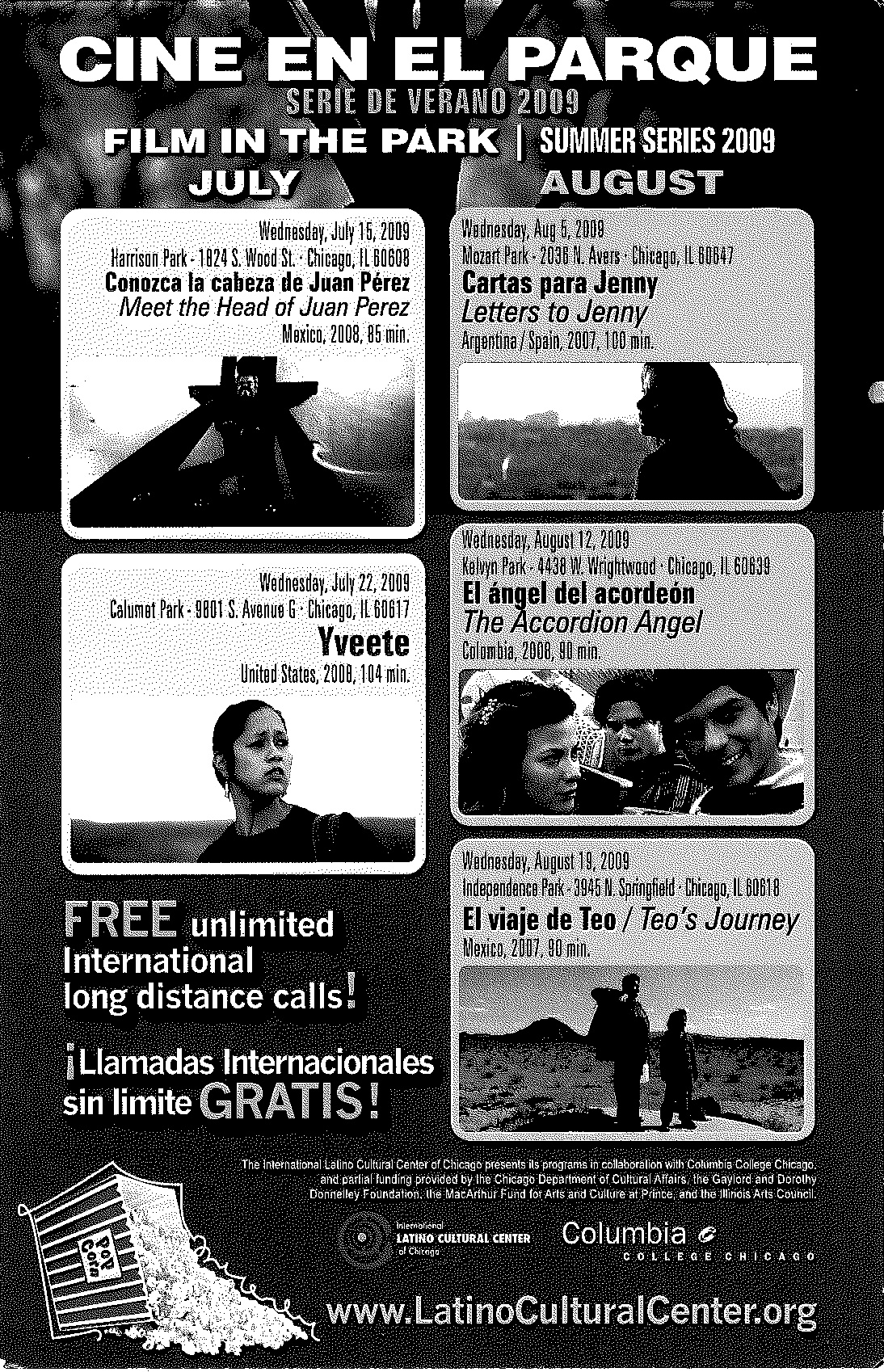
Then, in 2006, in partnership with the Chicago Parks District, the ILCC started taking the more family friendly fare of past festivals to different parks across the city, mostly in majority-Latino neighborhoods. Titled Films in the Park and presented as part of the Park District’s summer long Movies in the Park program, the series marked the first time foreign language films were screened outdoors in the city’s parks. Between five and nine films are screened each year, depending on the slots assigned by the city. The series provided families the opportunity to enjoy, free of charge, films that they otherwise would not have the chance to see in a setting that lends itself to community building.
Although the ILCC is strongly committed to continuing such free programs as Films in the Park, the Chicago Latino Dance Festival and many of the concerts it presents free of charge throughout the year, the reality is that the organization has seen a significant reduction in the attendance of such events. Because of the recent indiscriminate ICE raids in our communities, most of our audiences are now afraid to come out, endangering the future of these and so many other events produced by our fellow arts organization. Which is why this year-round fundraising campaign is so important to the organization. The ILCC is also currently looking at different ways to broaden its audience outside of its traditional enclaves. The organization strongly believes that by bringing new audiences to the fold, they not only will be combating the many prejudices against and misconceptions about the community but these new audiences will find common ground with the Latino community through these events.
HERE’S HOW YOU CAN HELP:
As part of its fundraising campaign commemorating its 25th anniversary, the International Latino Cultural Center will be hosting a dinner celebration at CineCity Studios, 2429 West 14th St. on Friday, November 14, featuring a solo performance from Grammy® and Latin Grammy® Award winning artist Alex Cuba and the very best in Latino cuisine. Doors open at 6 p.m. For more information, visit the ILCC’s official fundraising dinner page.
Unable to make the event? Never fear, you can still be part of our campaign with your individual contribution. Every single bit helps our mission to preserve in the city of Chicago a space for Pan-Latino arts in all its glorious disciplines. For more information on individual giving visit our individual giving page.
The International Latino Cultural Center of Chicago is a 501(3)(c) nonprofit cultural organization. All contributions are tax-deductible to the full extent allowed by the law.
